Aside from some Nordic and Spitz breeds, most dogs are not capable of verbally saying NO (okay so they don’t really say “no” but they can Arooo in a way that sounds like it)! They use their own physical language and rely on us to understand it–or at the very least have a rough working understanding. They also rely on their handlers to advocate for them–if your dog looks uncomfortable don’t let people approach and pet.
Unfortunately there are way too many dog owners who have very little working knowledge of dog body language and cannot effectively advocate for their dog. This lack of awareness of canine body language absolutely leads to dog to human bites and even fights between dogs. It really is of the utmost importance to educate ourselves and other dog handlers how to read some of the most basic canine “phrases.”
I’m going to post and give a little blurb about a variety of photos that show how dogs “say no” both to humans and to other dogs. Learning to recognize these postures/actions can help you prevent a dog bite. Look at the photo before reading the analysis and ask yourself, is this a dog you would pet if the pet owner said “sure, you can pet him.”
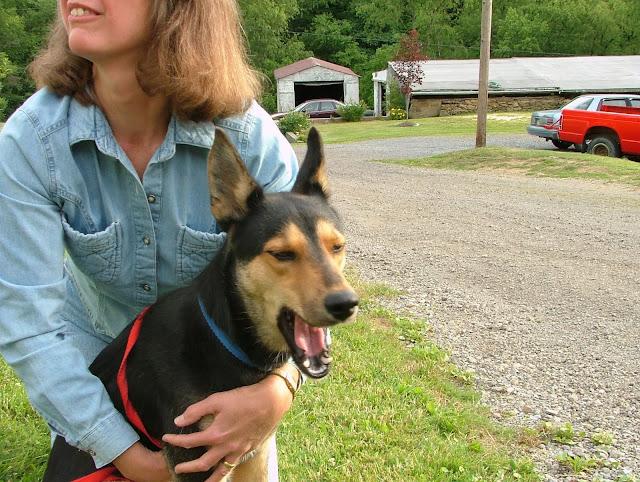 Dogs do NOT like hugs!
Dogs do NOT like hugs!
Heidi is being embraced by an adult female and is clearly stressed out. How do I know? Heidi is yawning, her ears are back and to the side (or they are mid flick), and she’s leaning away from the embrace. She is also mid blink and an increase rate of blinking is a sign of stress (can’t tell the rate of blinking from the image though).
*
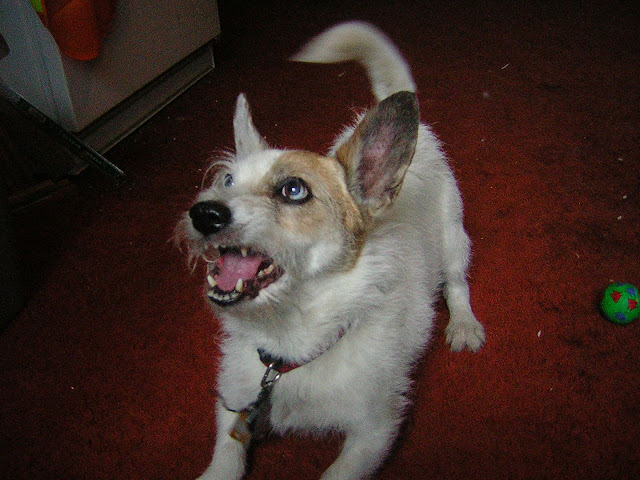 GET BACK!
GET BACK!
Willie is sending very clear, get back signals. He has a very hard eyes, intense stare, has some whale eye it looks like (hard to tell w/ the blue), his ears are quite forward, his whiskers are forward, has an aggressive tooth display, his body is cocked back ready to strike, and his tail looks to be flagging (a staccato-like wagging motion).
*
 I’m not comfortable!
I’m not comfortable!
Neither girl is particularly comfortable in this photo. Risa is offering quite a few appeasement gestures: low head, curved approach, and I think she licked Shayne’s muzzle. Shayne responded by dropping her head, licking her lips, looking away and giving a whale eye (barely visible in photo).
*
 I do not like this!
I do not like this!
This pup is being hovered over by a handler while having his collar grabbed. His ears are pulled back, he’s crouched a little low, he is licking his lips, and his weight is shifted backwards (just waiting to flee).
His tail is wagging…but does he look happy?
*
 Not okay, please go away!
Not okay, please go away!
Risa is very uncomfortable here. Her ears are pinned back, she has a huge whale eye, her commissures are pulled forward, and her brow is furrowed slightly. She may also be about to roll on her side, which is a cut off behavior (remember Shayne’s belly photo from yesterday?).
*
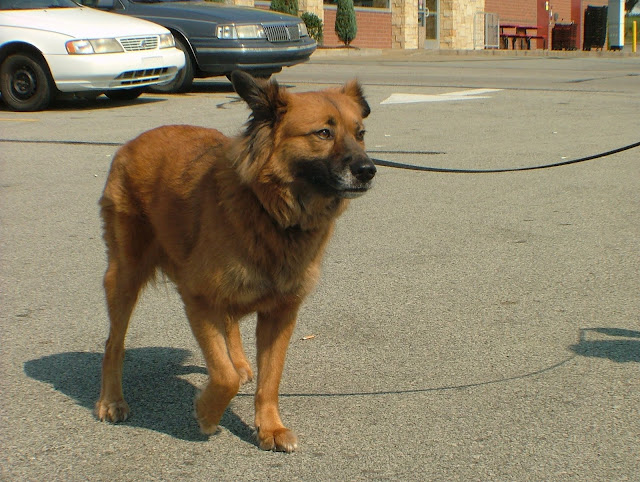 Can I run away yet?
Can I run away yet?
Chloe, is very uncomfortable and given the chance, would probably flee in an instant.
Chloe’s ears are back and to the side, her mouth is tightly closed, her brow is furrowed, her tail is very low (shadow indicates), she’s walking a little “low” and her weight is backwards. If she was stationary, the raised paw also indicates concern.
*
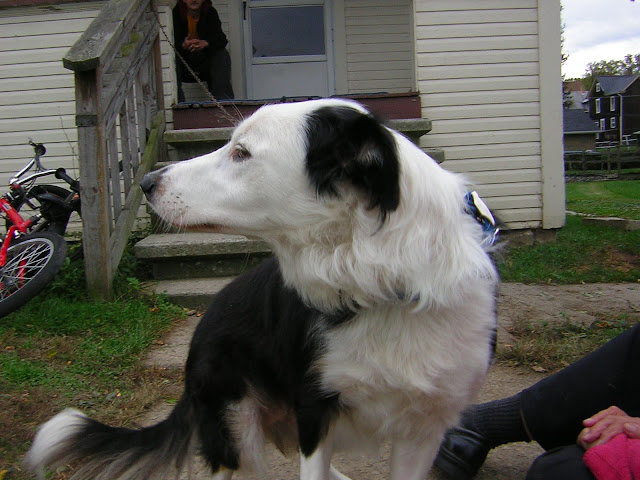 I’d rather you didn’t pet me…
I’d rather you didn’t pet me…
She is doing a very strong look away, her ears are pinned back, mouth closed tightly, face is tense, and whiskers are pushed forward.
This is the look that many dogs give when they don’t want pet, yet handler and stranger have no clue what the dog is saying. For a dog with a low bite threshold, this could be all the warning you get before a bite happens.
*
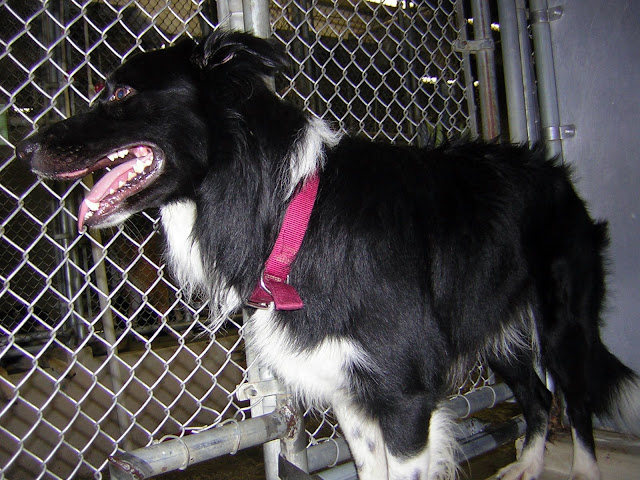 I’m pretty uncomfortable…
I’m pretty uncomfortable…
This dog is not smiling and relaxed. He is showing multiple signs of being quite stressed and if it were the “wrong” dog, it could be enough of a warning to bite.
His ears are pinned back, he is avoiding eye contact, has moved as far away from the camera as possible, his eyes are dilated, his face is tense, and he’s panting (unsure of whether that is weather related).
*
 UH OH!
UH OH!
Okay, aside from the photobomb by Tas, this picture makes me so uncomfortable!
Not that you can tell, but what’s going on in this photograph is both slow/no movement and then a momentary freeze by Shayne. Both very ominous signs of bad news. Risa (the darker dog) is offering some calming signals along with some stress signals (she’s a little confused), her ears are pinned back, her head is lowered and curved (calming) but her whiskers are pushed forward, her mouth is tightly closed, and she is staring (yet looking away). Shayne is not doing a good job at communicating. She is very stiff, ears forward, mouth tightly closed, yet her weight is backwards. These two girls got in quite the pickle in this interaction… they got too close and neither felt comfortable enough to know how to get out of it (though part of Risa was trying to make Shayne comfy… yet the other part wasn’t LOL). As soon as I saw the stillness, I called Shayne away because a scuffle would have happened if someone didn’t break the tension–again just looking at this photo I can feel the tension.
How many of these dogs would you have approached if the owner said “SURE!” ? All of these dogs are giving signs/warnings that they are uncomfortable. While some or more subtle than others, all are communicating stress/discomfort. For some dogs, these are the types of warnings that are given before a bite (though I would venture that most dogs will give more warning than the subtle ones here). Not all dogs will growl loudly or give an impressive aggressive tooth display… many will give a whale eye, yawn, lip lick, blink and look away before they choose to go in for a bite if the person continues to get close/pet (a bite is often a more physical communication that they want you to back off).
So, what does this mean? Dogs who bite don’t always look aggressive to the naked eye but they all will give you some signals. So before you pet a dog or allow someone to pet your dog, ask your dog–what is he/she saying through their body? Are they comfortable? Do they want to engage? Or, do they want to get the heck out of Dodge? Even if a person says you can pet their dog, if the dog is giving off uncomfortable/fearful/anxious type body language, take the safe route and admire from afar.
Photos are still captures, it’s very hard to catch some of the warning behaviors like slow or little movement, paw raises, pacing, freezes, dogs who aren’t eating, and hyper vigilant behavior. Also there is a stress behavior that is actually pretty common that I couldn’t find a photo of (for good reason) . Dogs who are stressed will often break the tension by sniffing or licking their genitals or butt. Shayne does this with her tail, if she’s stressed, she’ll plop down and nibble the base of her tail.
Thank you to Crystal and Jamie for the use of their fantastic photos!!
**Just an aside, photos caption just one instance in time, these photos may not represent the actual nature or behavior of the dog… it just captures about 1/120th of a second in time and in that 1/120th of a second the dog was displaying those behaviors.






Hi! Sam here from the Saturday blog hop (#69 It’s a RRRuff Life). What a great post! I personally have only bit 1 person. That was a kid who poked me in the eye and then I did not break the skin, it was just a warning nip! And I did not give any warning (Neither did the kid!).
Anyway, I enjoyed reading the post and I learned about other dogs!
RRRuff
Sam
Pingback: Dog bite prevention work saves lives | Saving Starfish
Great post and great set of photos. So many times you see these signs – even when owners are petting their own dogs! Thanks for posting.
Pingback: My Seven Links | Success Just Clicks
Definitely a useful post, especially with all the helpful photos. I can understand some people not being able to read strange dogs, but it amazes me how many people can’t read their own dogs. I was walking my Leah when I first adopted her, and a strange dog jumped up on a storm door, (lock those doors people), and came charging out of the house. Then, even as the owner is yelling to me, “Don’t worry, he doesn’t bite,” his pace slowed substantially, he’s ears and lips were pushed forward, and his tail stuck straight out. I started backing away with Leah, but it was too late. He attacked her and his owner couldn’t even get him off of her.
I actually had to let go of her leash and tell her to run, and the moment she broke free, she did. (Thank god, she didn’t go far, and she only had a minor bite). It was so scary, and I knew from the moment that dog left the house what his intentions were, even as his owner was assuring me he was safe.
Pingback: Weekly Woof from the Web | Pet Central's Pawsitive Dawgs Blog!
Funny, your “Uh Oh” pic got a ‘whoa!’ from me. That tight bodied freeze, engaged taught muscles…
Curious did you recall or watch?
Great piece, Tena!
Peace~
LOL! Yeah, I just recalled her and it was fine as soon as I broke the tension (just watching would have ended badly). The girls aren’t confident/comfortable enough to know how to get out of a situation without resorting to snarking because neither feels comfortable enough to look away/leave. It isn’t as big of a deal if the OTHER dog is really social and they can diffuse the situation by looking away/leaving (so shayne paired with really socially savvy dogs doesn’t result in many issues anymore since they quickly learn she doesn’t want to play). They are surprisingly good together, we just have to look out for these moments where they get tangled and need some help getting unstuck, other than that they can coexist quite nicely by not really interacting too much, just hanging out.
I always get nervous when that situation presents itself here. Hops and Si. are the problems here. The best results have almost always been a happy recall. But even that can be scary Once again great post Tena. I will be sharing it on our blog sometime soon.
Peace~
Thanks for sharing. I’ve been using BAT with Shayne to help her to offer a look-away in stressful situations and it seems to be making a difference in these “uh-oh” moments. It’s been quite the process and it’s not perfect yet but in more and more instances if she’s uncomfortable she does a look away or lip lick so I will add distance between her and the situation. I’ve been working towards her offering these behaviors during a greeting… i’m not there yet but it’s been improving.
Do you have a good write up of BAT and CAT?
Neither has struck me as really awesome, but then I’ve never seen it done in person and have never spoken to an ‘expert’ at the techniques. I’d like to learn more about them.
Peace~
I personally really don’t like CAT.. it is way too close to flooding… push the dog over the edge and wait for them to come down… eh, not my thing. BAT works dogs under threshold and utilizes functional life rewards (adding distance). My write-up isn’t the clearest I don’t think, but it does have a nice video that Grisha put together… Going Bat, Bat, Batty. I’ve gotten really great results with Shayne and with the reactive dogs in my classes choosing to offer a calming signal instead of reacting…plus the dogs are learning to make good choices. A great byproduct is that handlers are learning to read their dogs better and are better able to advocate for their dog since they can read the body language better.
CAT struck me as flooding as well, and BAT strikes me as giving the dog reinforcement in the manner that they desire to fit their ‘need’ in any given situation.
I like to offer alternative reinforcement to what the dog ‘needs’, usually food, in stressful situations – affecting the physiology to address irrational fears – so I was not initially impressed with BAT. I’ve continued to mix the two up since I heard of them a year or two ago.
Your Going Batty piece (really nice, btw) helped separate the two for me a bit, but I’m still not sold. I’d love to hear more…
I’ll check out the book when it comes out.
Peace~
The book came out a few weeks ago and is AMAZING! I love my copy lots (you can buy the book from Grisha’s store…here)!
You can absolutely use food as an additional reward to the adding distance. You can also do classical/counter conditioning and desensitization using food to address the conditioned emotional response as a separate piece of training work, though I’ve found using BAT, even without food, has had a counter conditioning effect (obviously not the same as straight up CC&D). The dogs seem to become less concerned over the scary thing because they’ve learned that they control the environment and they learn a way out of the interaction if it’s too much for them.
What makes BAT so useful is that there are a multitude of positive effects with the dog and that it can be used in so many venues and that there is so much room in the general protocol to cater to the specific dog/need.
Prior to doing BAT work, Shayne was not very good at communicating with other dogs. She rarely offered calming signals and would just focus on and stare at an oncoming dog with her respiration rate going through the roof and would half wag/half flag her tail–she was clearly hard for dogs to read because most dogs were drawn to her. She had a very hard time breaking her BC stare and it was BAD if another dog did a nose-to-nose greeting (she would get stuck in that UH-OH stance and then snark and give a big display to end it)–she was not comfortable and had no idea how to prevent or end an interaction (I tried my best to tell down owners that she wasn’t friendly or was afraid of other dogs but in NY sometimes dogs would surprise us). Through BAT she will now offer calming signals to dogs at a distance and will give big look-aways and other dogs have been MUCH less likely to WANT to see her (LOL). She’s much easier for them to read. On top of that, she has learned how to control her environment in much more appropriate ways–if I have her in a very situation she’s not comfortable… when she hits her threshold she will yawn/lip lick/look away to let me know she wants out of that environment… her solution previously would have been to have a reaction. Avoiding the reaction all together helps shift body chemistry and prevents the surge of cortisol/adrenaline/other brain chemicals and keeps the body more at a physiological baseline–which in and of itself helps prevent reactions.
BAT has really become a big piece of how I work with reactive (even aggressive) dogs and I’ve seen really great results
Nice, Tena.
I guess I have to pick up that book.
Pingback: Try not to hug the new family member | Puddin's Training Tips | a mySA.com blog
Pingback: Great or not so great: the value of “tolerance.” | Saving Starfish
Pingback: The Not-so-Great Dane video: Patience ≠ Permission | Saving Starfish